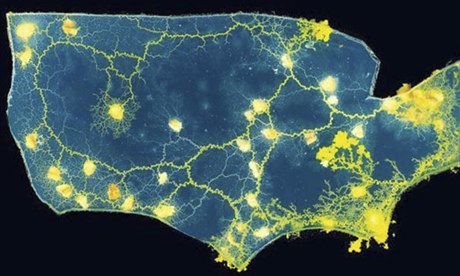
When asked, slime mould would reroute the M6. For years now, researchers in the field of urban transport have looked at biomimicry as a tool for establishing the most efficient routes around congested cities, typically by road or rail.
The use of naturally occurring living organisms to solve spatial design problems has, in this area, variously been explored by mimicking the foraging process of ants or the growth of crystal structures. But it is a particular form of slime mould, Physarum polycephalum (the "many-headed slime"), that has shown particular promise, having been applied to cities around the world and now offering the potential for mimicking regularly occurring events, such as rush hours.
P polycephalum is a plasmodial, single-celled organism which grows outward from a single point, searching for food sources. Once these have been located, the many branches it has sent out die back, leaving only the most efficient route between food source nodes.
By arranging pieces of oatmeal on a Petri dish to represent railway stations, researchers at the University of Hokkaido in Japan successfully grew a slime mould model of the Tokyo rail system in 2010. Since then, slime has mapped the optimum transport networks of numerous cities, as well as the Silk Road and a full global trade route.
In a comparison of 14 countries' motorway networks, a global team of researchers led by Professor Andrew Adamatzky – director of the unconventional computing centre at the University of the West of England – used oat flakes and slime to establish that cities in Belgium, Canada and China had existing transport networks most similar to the slime model, and thus were most efficient, while networks in the US and Africa were indicated to be the least efficient.
Closer to home, when Adamatzky's team mapped the UK motorway network, the M4 motorway between Bristol and London very rarely occurred, with the plasmodium instead routing traffic through the West Midlands.
Furthermore, according to the slime mould's point of view, the M6/M74 should be rerouted through Newcastle, linking London to Glasgow along the east rather than the west coast.
Mapping by slime mould has a number of benefits, not least its relative ease and speed. Slime mould grows at 1cm an hour in optimum conditions, and will successfully map most problems in a few days. The established network is still a living "supercell" (effectively a single cell with multiple nuclei), and as a result, can also become a dynamic modelling tool.
For example, problems in the system such as a road crash or flooding can be simulated by simply adding salt at the relevant point on the map. Salt is toxic to the plasmodium and the organism will retract from it, strengthening other lines and opening new routes across the network, which can thus provide information for traffic planning contingencies.
Up to now, research has not included types of terrain such as rivers or mountains, nor any understanding of social and political factors. It will only map the most efficient route to all points. But current research suggests the slime mould leaves chemical markers on unsuccessful routes as a reminder. This could be used in the future to indicate terrain features missing from current models.
This developing form of biomimicry demonstrates some of the possibilities of using unconventional computing in urban planning, and as slime mould techniques are increasingly employed so does our understanding of what this complex organism can teach us.
Most intriguing of all is the potential for the mould to "expect" changes in its environment. Back in 2008, researchers at Hokkaido University repeatedly subjected successfully growing slime moulds to low temperatures and dry air every 30 minutes. Not the best conditions to grow slime in; so as expected, growth rates slowed.
When the researchers then stopped applying poor growth conditions, however, half of the slime moulds tested still slowed their growth rate 30 minutes later, in expectation of the stimulus. Such behaviour could potentially be used to get transport network models to adapt to regularly occurring events, such as rush hours, or as a planning tool for project management. For the moment, though, the mechanisms behind this aspect of the slime mould's behaviour remain poorly understood.

